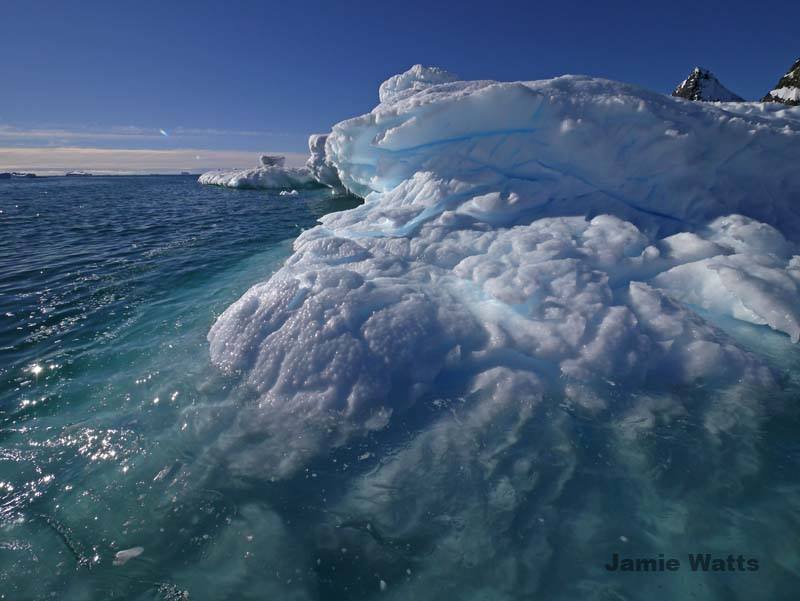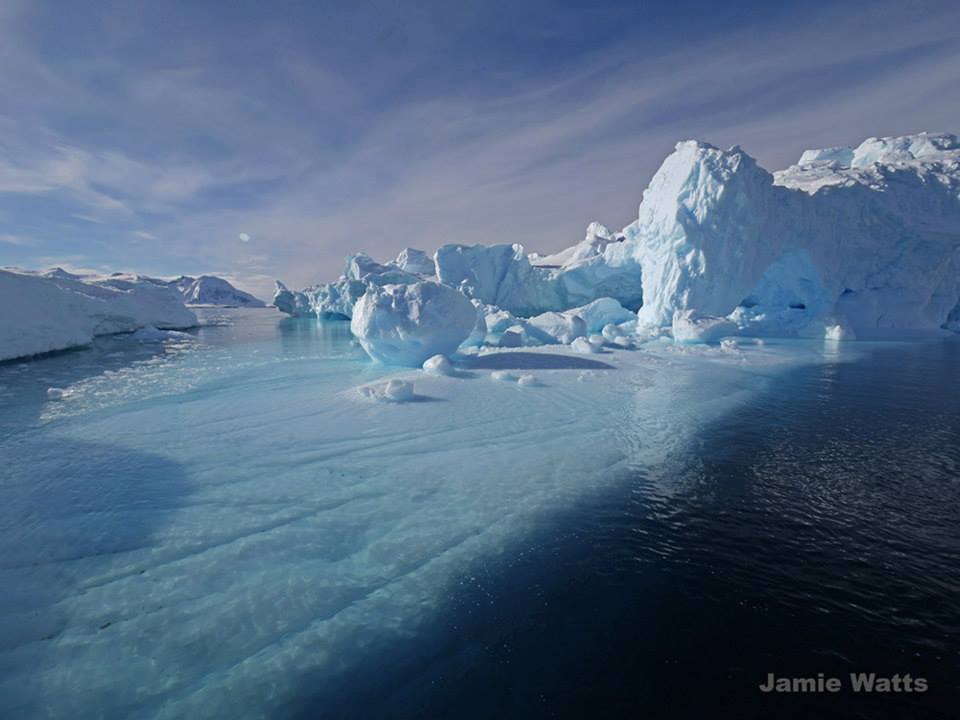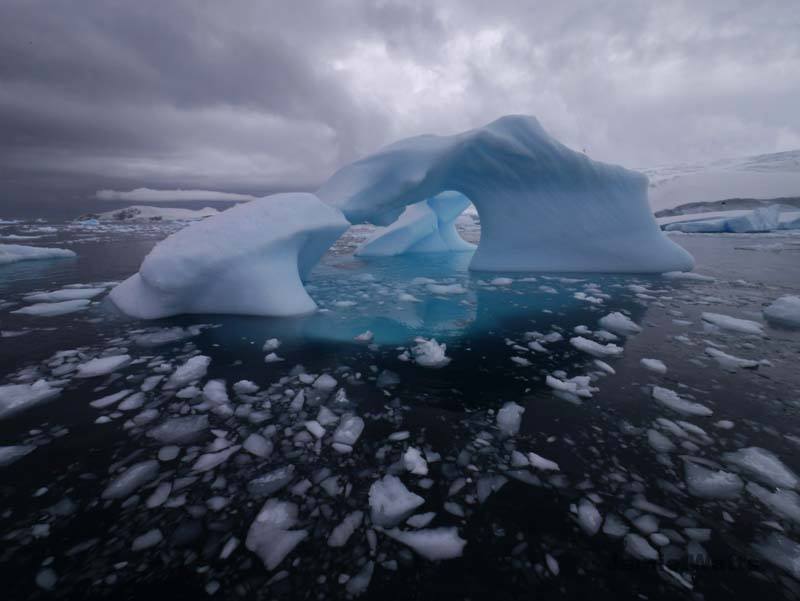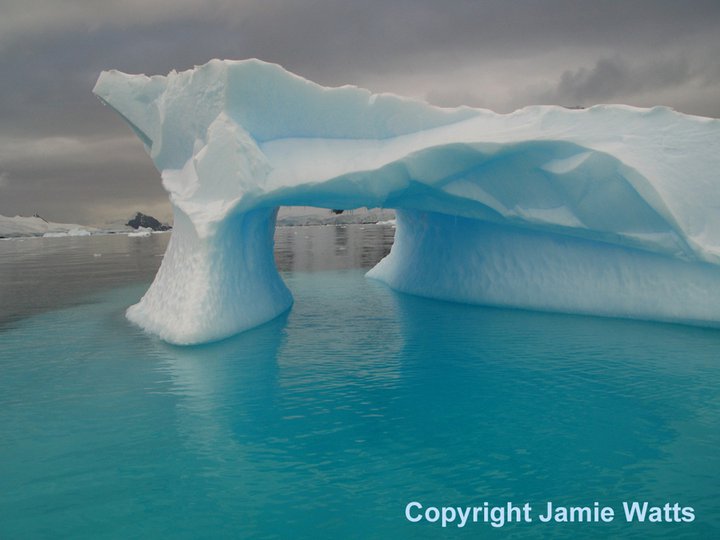Marine Life & Conservation
Whales In The Antarctic
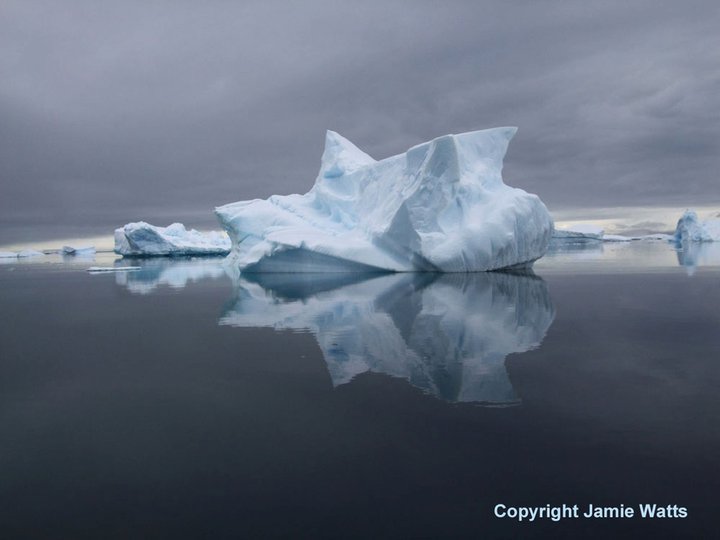
I’ve been coming down to the Antarctic Peninsula nine long summers now, and every year the humpbacks become more conspicuous, more numerous and more interactive. It’s a wonderful thing. Seven per cent population growth a year, researchers are estimating – as fast as they can possibly reproduce. Seven per cent is a magic number – it means doubling in a decade. By somewhere around the mid 2030s they should reach their pre-whaling levels.
We see minkes, mostly in amongst the loose brash, and we often see fin whales, generally out in the Drake or the open Scotia Sea. Very, very rarely we’ll see one of the giant blues; the Antarctic blue, the biggest subspecies of the biggest animal that ever lived – also the subspecies hit hardest by the whalers. But even with them there are positive signs; this year nine blues were seen together off South Georgia.
But the humpbacks – they move where we tourist ships move, outside the thickest ice but in amongst the islands. They don’t slice past us at speed like the others, but linger, stick around, even show curiosity for our Zodiacs and their inhabitants. They are the most playful, the most agile and athletic whale, the greatest migrator and the ones we know and love best.
Cierva Cove is close to where the Antarctic continent was first landed, 195 years ago. A stunning bay, boxed in somewhat by a couple of islands, with a magnificent glacier tumbling down into it from the spine of the Antarctic Peninsula beyond. It catches quite a few of the icebergs passing north from the Gerlache strait, and the back of the bay is impenetrable to our zodiacs much of the time with thick brash and massive bergs. It also catches nice pockets of krill, and this is why on this particular late February morning dozens of humpback whales were working the bay.
We started spotted them way out from our drifting position as soon as we had light – threes and fours, lunging at the surface. Further in we passed several groups close to the ship, and as we slowed down to lower Zodiacs they even started to approach more closely. They weren’t even slightly interested in the ship, I think, they were just working their way through the krill and it happened to bring them in our direction.
First whale up close and personal from the Zodiac was a youngster, perhaps eight or nine metres long and about ten tonnes. It’s a young population and many of these animals are just a few years old. He was energetic, multiple lunges near our little boat, and curious – he spy-hopped us. But he was also somewhat inefficient in his foraging. The faster, sleeker whales work alone and do fast lunges, but that’s not what works best for humpbacks. He was doing short, fast gulps, not opening his throat widely, but more importantly he wasn’t doing anything to herd the krill. Maybe a phone-booth’s volume of water each gulp, but probably only a kilo or so of krill with each mouthful.
The Antarctic krill is earth’s greatest protein and oil source, attracting the largest gatherings of marine mammals and birds on earth. But the average density even here is pretty low – to feed effectively you not only need to find the densest patches of krill but you need to gather them efficiently. Before whaling, the great whales had become ecologically a force to be reckoned with – the greatest consumers of food of any mammal group on the planet (unprecedented for carnivores) until the rise of humans. They were masters of the densest ocean food web of all, due to their stupendous foraging arsenal.
The next humpbacks were a bit more onto it. Three whales working together, they were working spirals, and at least one of them was bubble-netting. Humpback arms are the biggest limbs on earth – over five metres long in large animals. They look odd and lumpy, but it turns out the knobbles and patches of barnacles break up water turbulence, and these long wing-like arms are superbly efficient hydrofoils. Not only do they provide lift – these animals literally fly through the water on the longest migrations of any whale – but they can also bend and twist to give humpbacks incredible high-speed twists and turns that no other whale can perform.
Combined with their rather muscular build and a level of hunting coordination that has never been seen in other whales, this makes for an impressive krill-gathering ability. The larger of these three whales was bubble-netting; swimming below and around the edge of the krill swarm letting out a curtain of bubbles, which herds the krill towards the middle in a tight cluster. The other whales swam around the edge, waving their tails inwards. Then one at a time they would lunge in towards the middle of the prey cluster, taking a large gulp.
Another group appeared, closing in and before long was working alongside this trio – the two groups even looked to be helping each other out – packing their two krill patches tight right up against each other. The new trio included two larger animals – thirteen metres or more and perhaps thirty tonnes apiece, and both were bubble-netting. I have seen dozens of bubble-nets and they always spiral inwards to the right. Humpback whales, like Derek Zoolander, are not ambi-turners, apparently.
A couple of times the bubbles started to surface just ahead or just to the side of the Zodiac. I wasn’t concerned – I have never known a whale to be anything other than superbly aware, sensitive to and more than able to avoid boats or swimmers.
It seems that the humpbacks improve the art and technique of bubble-netting as they mature. It requires coordination and communication, as well as rather an impressive use of the ever-tightening turns afforded by those huge arms. We have no idea how they coordinate, or indeed how they are aware of or find the krill in the water, but the concentrations of krill they absolutely depend on – kilogrammes per cubic metre – are rather high. The two larger whales of the joining trio did a classic, elegant double spiral of bubble nets. The first whale started a ring about fifteen metres across, then fifteen seconds later a second set began to appear across the other side, both spiralling in together in a beautiful fractal symmetry. A pause and then a lunge – all three whales at 45 degrees upwards through the middle of the concentrated krill patch.
The sheer physics of the lunge itself is pretty impressive. Off Alaska where the humpbacks hunt faster-moving prey the lunges are fast, vertical and vast. Down here, the krill-eaters are somewhat more sedate, but still impressive. The smaller, younger animals seem to have less distendable throats and do shorter, almost horizontal surface lunges, sometimes flopping over on one side. I even saw a young whale last year porpoising over the top and opening its mouth as it came down on top of the krill patch.
The bigger, older whales seem to mature their abilities and perhaps become more physically flexible in the throat. They lunge straight upwards after a tight turn at the end of the bubble-net. They accelerate then snap their mouths open wide – up to about right angles – at the last couple of seconds just before they hit the surface. The articulation of the jaw opens out on elastic tendons, and the front joint of the jaw is similarly flexible so that the arch of the jaw opens outwards to widen the scoop. The forces are enormous. The grooved throat balloons out to about the size of a small garage to take in up to twenty tonnes of water in a large adult, the sofa-sized tongue turned inside out by the force of the sudden opening of the parachute-like gape. The mouth then snaps shut, sealing quickly at the front of the lips, squeezing out tonne after tonne of water through the filter of the baleen plates hanging from the sides of the top lip as it zips shut from the tip of the snout backwards on either side. Then the throat squeezes, water gushing back through the baleen and out of the downturned corners of the mouth over the eyes. The sides of the jaw and the muscular throat, deformed by the pressure of the lunge, slowly pull back into place.
An Antarctic humpback might gather tens of kilos with each gulp, and after a good morning of feeding have a tonne of krill in their stomach. Only the fin and blue whales, with their even larger gapes and faster open-water lunges can gather more. The humpbacks gorge themselves, defecating as they are feeding to make space to squeeze in more krill, the big ones gaining ten to fifteen tonnes in a season. The largest get to fifty tonnes or more, as big as the largest dinosaurs. The faeces seeds the ocean with iron – and until 75 years ago gave the Southern Ocean an iron boost that fertilized the seas and drove up plankton productivity as well as natural carbon sequestration. And they’re coming back.
In every direction, groups of three to four whales moved around, sometimes coming together as clusters, sometimes spy-hopping close to our boats. We left them for a while to play in the brash and look at some icebergs and a dozing leopard seal, but on the way back to the ship came across more groups. We had to get back, the ship had to leave, to head north towards Elephant Island then South Georgia.
Oh all right, then, one more group of whales….
Visit Jamie’s website for all his latest news and blogs: www.jamiewatts.co.uk
Jamie’s blog was provided by Oonasdivers.
Blogs
The Ocean Cleanup Breaks 10,000,000 KG Barrier

The Ocean Cleanup, the global non-profit project, has removed a verified all-time total of ten million kilograms (22 million lbs.) of trash from oceans and rivers around the world – approximately the same weight as the Eiffel Tower.
To complete its mission of ridding the oceans of plastic, The Ocean Cleanup uses a dual strategy: cleaning up the Great Pacific Garbage Patch (GPGP) to remove the plastic already afloat in the oceans, while stopping the flow of plastic from the world’s most polluting rivers.
Through cleaning operations in the GPGP and in rivers in eight countries, the cumulative total of trash removed has now surpassed ten million kilograms. This milestone demonstrates the acceleration of The Ocean Cleanup’s impact, while underlining the astonishing scale of the plastic pollution problem and the need for continued support and action.
While encouraging for the mission, this milestone is only a staging point: millions more tons of plastic still pollute our oceans and The Ocean Cleanup intends to continue learning, improving and innovating to solve this global catastrophe.
This announcement comes as governments from around the world meet to continue negotiations to develop a new legally binding instrument to end plastic pollution at INC4 in Ottawa, Canada. Representatives of The Ocean Cleanup will be in attendance and the organization will be urging decision-makers to collaborate towards a comprehensive and ambitious global treaty which addresses plastic at all stages of its life cycle and in all marine environments worldwide, including in areas beyond national jurisdiction.
It is encouraging to see that the need for remediation is reflected in the various options for potential treaty provisions. It is essential that the final treaty contains clear targets for the remediation of legacy plastic pollution, and reduction of riverine plastic emissions.
Tackling plastic pollution requires innovative and impactful solutions. The treaty should therefore incentivize the innovation ecosystem by fostering innovations that make maximal use of data, technology and scientific knowledge – such as those designed and deployed by The Ocean Cleanup.
‘After many tough years of trial and error, it’s amazing to see our work is starting to pay off – and I am proud of the team who has brought us to this point.’ said Boyan Slat, Founder and CEO of The Ocean Cleanup. ‘While we still have a long way to go, our recent successes fill us with renewed confidence that the oceans can be cleaned.’
The Ocean Cleanup was founded in 2013 and captured its first plastic in 2019, with the first confirmed catch in the GPGP coming soon after the deployment of Interceptor 001 in Jakarta, Indonesia. After surpassing one million kilograms of trash removed in early 2022, the non-profit project has since progressed to the third iteration of its GPGP cleaning solution, known as System 03, and a network of Interceptors currently covering rivers in eight countries, with more deployments set for 2024.
About The Ocean Cleanup
The Ocean Cleanup is an international non-profit organization that develops and scales technologies to rid the world’s oceans of plastic. They aim to achieve this goal through a dual strategy: stemming the inflow via rivers and cleaning up the legacy plastic that has already accumulated in the ocean. For the latter, The Ocean Cleanup develops large-scale systems to efficiently concentrate the plastic for periodic removal. This plastic is tracked and traced through DNV’s chain of custody model to certify claims of origin when recycling it into new products. To curb the tide via rivers, The Ocean Cleanup has developed Interceptor™ solutions to halt and extract riverine plastic before it reaches the ocean. Founded in 2013 by Boyan Slat, The Ocean Cleanup now employs a broadly multi-disciplined team of approximately 140. The foundation is headquartered in Rotterdam, the Netherlands.
For more information, visit: theoceancleanup.com and follow @theoceancleanup on social media.
Marine Life & Conservation
Steve Backshall to headline Shark Trust’s flagship event: For the Love of Sharks

Join a host of amazing, shark loving, speakers including Steve Backshall and the Shark Trust team for an evening celebrating shark conservation at the Royal Geographical Society in London this November.
Date: 29th November 2024
Time: 6-10pm
Location: Royal Geographical Society, London
Tickets: https://www.sharktrust.org/Event/flos24
The event will be a celebration of all things shark. Those lucky enough to get hold of tickets will hear from engaging guest speakers with a passion for sharks.
The line-up includes (*subject to change if unforeseen circumstances arise)
Steve Backshall: One of television’s busiest presenters, BAFTA award-winning wildlife expert Steve has been passionate about the wild world ever since he was young.
Steve’s impressive TV career has taken him all around the world, investigating a wide array of species and environments. Steve has filmed over 100 hours of children’s wildlife programmes with the BAFTA award winning Deadly 60 franchise and recently, with Sky Nature, for his new series ‘Whale with Steve Backshall’. He has been a patron for the Shark Trust for 10 years.
Simon Rogerson: is a photojournalist specialising in natural history, diving and the sea.
He is editor of SCUBA magazine, the official journal of the British Sub-Aqua Club. Simon started his career as a crime reporter but gravitated towards his ‘less depressing’ interest in underwater exploration, joining the staff of DIVE magazine in 1999. In 2005 he was named ‘Editor of the Year’ in the PPA’s Independent Publishing Awards. Simon also works as a freelance writer, contributing frequently to the Sunday Times and Telegraph, in addition to BBC Wildlife, Esquire, and a host of international diving magazines. He is the author of a book, Dive Red Sea, published by Ultimate Sports. Now based in Berkshire, Simon has been a Patron of the Shark Trust for 20 years.
More speakers to be announced soon. Head to the Shark Trust website to learn more.
The evening will also allow guests the final chance to see the Oceanic 31, shark art exhibition. Some of the artwork will be auctioned/raffled at the event, while the rest will be auctioned online to raise money for the Shark Trust Oceanic Programme.
For the Love of Sharks is an evening with something for everyone who is interested and fascinated by sharks. Join the Shark Trust, their Patrons, Trustees and Staff, along with a host of supporters for this celebration of shark conservation.
For more information or to buy a ticket: https://www.sharktrust.org/Event/flos24
-

 News3 months ago
News3 months agoCapturing Critters in Lembeh Underwater Photography Workshop 2024: Event Roundup
-

 Marine Life & Conservation Blogs3 months ago
Marine Life & Conservation Blogs3 months agoCreature Feature: Swell Sharks
-

 Blogs2 months ago
Blogs2 months agoMurex Resorts: Passport to Paradise!
-

 Blogs2 months ago
Blogs2 months agoDiver Discovering Whale Skeletons Beneath Ice Judged World’s Best Underwater Photograph
-

 Gear Reviews3 weeks ago
Gear Reviews3 weeks agoGEAR REVIEW – Revolutionising Diving Comfort: The Sharkskin T2 Chillproof Suit
-

 Gear Reviews3 months ago
Gear Reviews3 months agoGear Review: Oceanic+ Dive Housing for iPhone
-

 Marine Life & Conservation2 months ago
Marine Life & Conservation2 months agoSave the Manatee Club launches brand new webcams at Silver Springs State Park, Florida
-

 News2 months ago
News2 months agoPADI Teams Up with Wellness Brand Neuro to Drive Ocean Change and Create a Blue State of Mind


